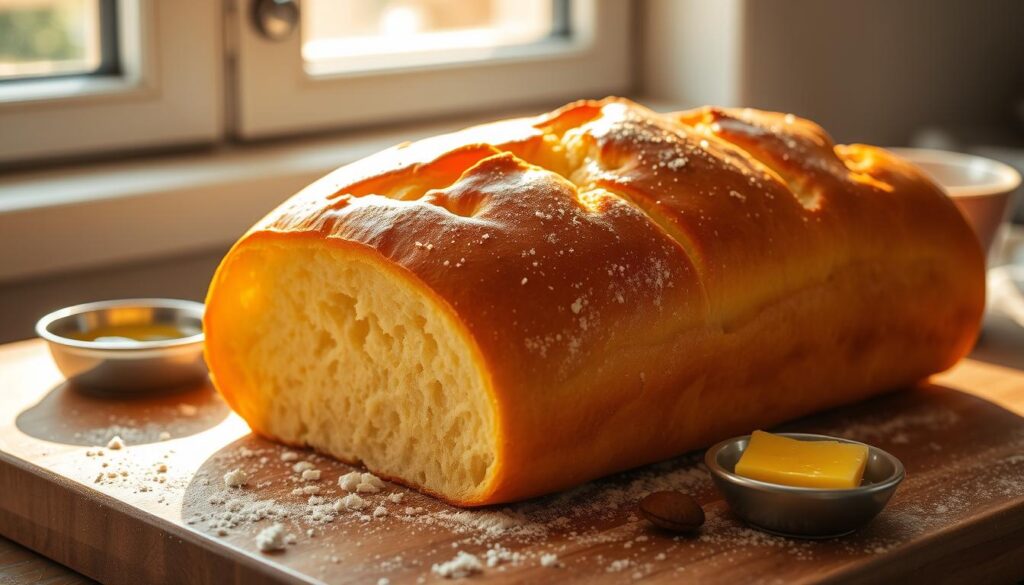Did you know brioche bread is a rich French treat? It’s made with butter and eggs. This easy recipe makes it simple to bake at home. It’s perfect for brunch or just enjoying fresh toast.
By following this method, you’ll get the buttery taste everyone loves. It’s a favorite in bakeries and homes. The recipe uses techniques from Le Cordon Bleu, making it easy for anyone to try.

Table of Contents
Key Takeaways
- Brioche is a French bread enriched with butter and eggs, making it soft and delicate.
- The recipe simplifies techniques from Le Cordon Bleu for home bakers.
- Active dry yeast is used, needing liquid for activation.
- Knead the dough for 20-30 minutes for optimal texture.
- The dough should rise 2-3 hours or can be refrigerated overnight.
- Bake at 375ºF for about 45 minutes for perfect results.
- Brioche can be frozen for up to 3 months without losing flavor.
What Makes Brioche Bread Unique?
Brioche bread is special because it’s a mix of bread and pastry. It comes from France and has a history going back to 1401. The brioche bread recipe uses butter, eggs, cream, and sugar. This makes it sweet and soft.
The Difference Between Bread and Pastry
Bread and pastry are different because of their ingredients and how they’re made. Bread has flour, water, salt, and yeast. But brioche adds fats and sugars. This makes it sweet and soft.
Characteristics of Brioche Bread
Brioche is known for its soft crumb and sweetness. It’s different from other breads. Here are its key features:
- It has a rich, buttery taste, thanks to lots of butter.
- It’s slightly sweet, great for both sweet and savory dishes.
- It’s versatile, used in French toast or savory dishes like stuffing.
Adding brioche to your meals can make them special. It’s perfect for brioche bread pudding or brioche burger buns. This dough adds gourmet flavors to your dishes.

Brioche Bread Recipe Ingredients
Making a classic brioche recipe needs careful picking of ingredients. These ingredients make the bread rich and flavorful. They work together to give the bread its soft texture and sweet taste. Here are the key ingredients for your brioche bread.
Essential Ingredients for Richness
The following ingredients are the base of your dough:
- 2 1/4 tsp active dry yeast
- ¼ cup lukewarm milk
- 2 tbsp sugar
- 3 large eggs
- 2.5 cups all-purpose flour
- 1 tsp salt
- ½ cup chilled butter
These ingredients are more than just basics. They are crucial for the bread’s structure and taste. Using fresh yeast and high-quality butter will enhance the final result.
Substitutions and Variations
Baking is a great way to be creative. The classic brioche recipe is wonderful, but you can try variations. Here are some ideas:
- Replace whole milk with nonfat milk for a lighter option.
- Consider using a mix of unsalted and light butter to adjust the richness.
- Add flavors such as vanilla extract or chocolate for a personalized touch.
- Utilize your dough to create sticky buns or fruit pizza, expanding your use of this versatile base.
If you’re looking for gluten-free options, you might find inspiration in alternatives. For example, gluten-free bagel recipes use different ingredients but still achieve a great texture.

Step-by-Step Instructions for Making Brioche
Making brioche can seem hard, but it’s easy with a clear guide. Start by making the dough. Then, use kneading techniques to get the brioche’s special texture.
Preparing the Dough
Begin by mixing yeast with warm milk in a bowl. Use 1 cup (245 g) of milk and 1 packet (about 2 ¼ teaspoons) of yeast. Stir until the yeast dissolves, then wait 5-10 minutes for it to froth.
In another bowl, mix 4 cups (500 g) of flour and 1 teaspoon of salt. Make a well and add eggs and yeast mixture. Mix in flour, then add ½ cup (1 stick / 113 g) of butter. Let it rest in the fridge overnight.
Kneading Techniques
When kneading time comes, let the dough warm up. Use a stand mixer or knead by hand for 10-15 minutes. Brioche dough is soft and sticky, so don’t add too much flour.
Let the dough rise at room temperature for 3 hours. It should double in size. Keep an eye on it and adjust moisture as needed. For more tips, check out this delicious bread recipe.
| Ingredient | Amount |
|---|---|
| Whole Milk | 1 cup (245 g) |
| Granulated Sugar | ½ cup (100 g) |
| Active Dry Yeast | 1 packet (about 2 ¼ teaspoons) |
| Large Eggs | 2 (at room temperature) |
| All-Purpose Flour | 4 cups (500 g) |
| Unsalted Butter | ½ cup (1 stick / 113 g) |
| Kosher Salt | 1 teaspoon |
| Egg Wash | 1 large egg + 1 tablespoon whole milk |
Baking Tips for Perfect Brioche
Baking brioche needs careful attention to get that perfect loaf. Follow these tips for a soft, fluffy, and tasty treat. Temperature control and watching the dough proofing are key.
Temperature Control and Equipment
Keeping the temperature right is crucial for brioche baking. Proof the dough in a warm spot for the yeast to work well. Aim for a 75ºF temperature. If it’s cooler, use a warm oven or a warm appliance.
Good equipment makes baking better. Use a strong stand mixer and well-greased loaf pans to avoid sticking. Bake at 375ºF. A digital thermometer helps check the dough’s internal temperature, aiming for 190ºF-200ºF.
Monitoring Dough Proofing
Watching the dough proofing stages is vital for the right texture. Let it rise until it doubles, usually in 30 minutes in a warm place. Look for a puffy dough and softness when tapped.
When shaping, do the folding process with breaks in between. After shaping, let it rise again for about 2 hours before baking. This step boosts flavor and fluffiness. Watch it to avoid over-proofing, which can cause it to collapse.

Why Cold Fermentation Matters
Cold fermentation brioche changes the game in bread-making. It lets the dough rise in cooler air, making the bread better in texture and taste. This method shows how rising the dough overnight leads to amazing results.
The Benefits of Overnight Rising
Overnight rising is great for brioche dough. It helps the gluten develop and prevents the dough from getting too puffy. The best fridge temperature is around 5°C (41°F), allowing the dough to ferment well over 12 to 24 hours.
The dough’s final temperature should be between 23°C (73°F) and 25°C (77°F). This slow process makes the dough tender and easier to shape.
Flavor Development Through Fermentation
Cold fermentation boosts flavor in brioche. Yeast works best at warmer temperatures, but this method ferments slowly. This slow process creates deep, complex flavors.
As the dough ferments, it gets richer in taste. Cold fermentation brioche tastes better than bread made at room temperature. For more on fermentation, check out this resource.
Storing and Freezing Homemade Brioche
Keeping brioche bread fresh is key. Knowing how to store and freeze it lets you enjoy it longer. This way, your homemade brioche stays delicious for days.
Best Practices for Storage
To keep brioche soft and flavorful, cool it on a wire rack first. Store it in an airtight container at room temperature for 2-3 days. If you’re baking the next day, refrigerate it after shaping and proofing. This slows down spoilage.
How to Freeze Brioche Effectively
Freezing brioche keeps it fresh for up to 2 months. Wrap it tightly in plastic wrap or a freezer-safe bag. Remove as much air as you can to prevent freezer burn.
To thaw, preheat your oven to 350°F/180°C and reheat for 30-35 minutes. This makes your brioche taste like it was just baked. You can also use leftover brioche in recipes like bread pudding or French toast. This adds a fun twist to your meals. For more ideas, check out this link.
Serving Suggestions for Your Brioche Loaf
Your homemade brioche loaf offers endless serving options. Enjoy it for breakfast or in gourmet sandwiches. Its buttery, airy texture is perfect with spreads and toppings.
Perfect Pairings with Brioche Bread
Start your day with warm brioche and butter or jam. This simple mix makes breakfast special. Try it with French toast or bread pudding for a sweet treat.
For lunch or dinner, make tasty sandwiches with brioche. Try crab and Gruyère cheese or a grilled cheese with a twist. Brioche buns are great for burgers, making any meal memorable.
For rich flavors, use brioche in savory dishes. It’s great with creamy sauces or Délice de Bourgogne cheese. Your dinner table can be a place for creativity with brioche.
Creative Uses for Brioche Bread
Brioche bread is more than just a loaf. It’s a canvas for creativity, with its buttery crumb and sweetness. You can use it in many ways, from breakfast to gourmet burgers. It’s a game-changer in the kitchen.
Recipes Using Brioche for French Toast
Brioche is perfect for French toast. Its soft texture soaks up egg mixtures beautifully. This makes for a rich, indulgent dish great for brunch.
Try these ideas:
- Brioche French toast with maple syrup and berries
- French toast casserole, ideal for feeding a crowd
- Fried brioche sticks for a fun breakfast treat
- Bostock, a delightful pastry made with almond cream
- Grilled brioche toast topped with seasonal fruits
These recipes make breakfast special. For something different, try a bacon breakfast casserole or a French toast waffle. Find more ideas online at veganbatter.com.
Making Brioche Burger Buns
Brioche is also great for burger buns. Its richness pairs well with savory fillings, making burgers more satisfying. Here are some ideas:
- Classic beef burgers on soft brioche buns
- Pineapple-teriyaki chicken burgers for a tropical flavor
- Veggie burgers layered with fresh toppings on brioche
Brioche’s soft, sweet flavor complements burgers well. It keeps its shape, even with juicy fillings. Use leftover brioche for croutons or bread topping for pot pie. It’s a versatile ingredient.
There are 21 unique brioche recipes to try. They range from sweet to savory, perfect for any meal. Brioche can elevate your cooking in many ways.
Common Mistakes to Avoid in Your Brioche Bread Recipe
Making perfect brioche is an art. It’s important to avoid common mistakes to succeed. Here are some tips to help you avoid common brioche baking issues.
Overworking the Dough
One common mistake is overworking the dough. Adding too much flour can make the loaf dense instead of light and airy. Brioche’s high butter content means it doesn’t form gluten easily. So, stick to the mixing time of about 35 minutes.
Rushing or over-manipulating the dough can ruin its structure. Always handle it gently.
Inadequate Proofing Times
Proper proofing is also crucial. Not enough proofing time can prevent the dough from rising well. Letting it rise uncovered for about 90 minutes is best for a fluffy texture.
Not following this time can lead to disappointing results. Make sure to plan enough time for baking. Brioche takes around 8.5 hours to make, including rising and baking.
By avoiding these common mistakes, you can improve your baking skills. You’ll make soft and flavorful brioche every time. If you want to try something new, check out more delicious recipes that use brioche.
Conclusion
Baking easy homemade brioche bread is a rewarding journey. It combines tradition with modern efficiency. By following the brioche bread recipe in this article, you can make a rich, buttery loaf.
The techniques like using a stand mixer and the windowpane test make it easier. They let you enjoy the process without getting stuck in old ways.
The tips for perfect brioche help you succeed. They focus on proofing and using a scale for accurate measurements. This makes your baking fun and successful.
Whether you enjoy your brioche with jam for breakfast or make gourmet French toast, the options are endless. Remember, the more you practice, the better you’ll get. Each try brings you closer to mastering this delicious bread.
Enjoy the satisfaction of baking at home. With the right guidance and patience, you can make a perfect loaf of brioche for any occasion. Make this delightful bread a part of your cooking routine!
F.A.Q
What is a brioche bread recipe?
A brioche bread recipe is a way to make homemade brioche. It’s a sweet, buttery bread. You need flour, eggs, butter, and sugar to make it. It’s soft and flavorful, great for French toast or sandwiches.
How is brioche different from regular bread?
Brioche has more butter and eggs than regular bread. This makes it softer and sweeter. It’s like a mix between bread and pastry, with a rich taste and soft crumb.
Can you provide a classic brioche recipe?
Yes! A classic brioche recipe mixes flour, yeast, sugar, eggs, milk, and butter. After kneading and proofing, shape the dough and let it rise. Then, bake it to get a delicious, lightly sweet loaf.
What are some easy brioche bread variations?
Easy variations include adding chocolate chips, vanilla, or dried fruits like raisins. You can also change the butter amount to make it richer.
How do I ensure my brioche dough rises properly?
To make sure it rises, keep the dough warm and away from drafts. Watch for it to double in size. This means it’s ready to bake.
What are some best practices for storing brioche?
Store brioche in an airtight container at room temperature or in the fridge for longer. If freezing, wrap it tightly. Thaw slowly to keep it soft.
What dishes can I create using brioche bread?
Brioche is very versatile. Use it for French toast, sandwiches, or even brioche burger buns. Its soft, buttery texture makes any dish better.
What are common mistakes to avoid when baking brioche?
Avoid overworking the dough to prevent a dense loaf. Also, make sure to proof it enough. This helps with flavor and texture. Follow kneading and proofing tips for better results.



